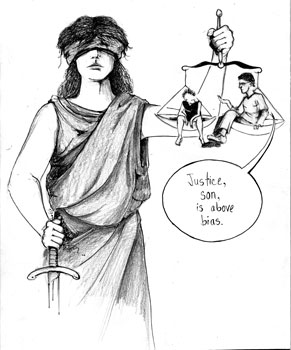
Editorial Archives — The Altamont Enterprise, March 26, 2009
Justice should be blind

Illustration by Forest Byrd
This is a year that saw an African American sworn in as president of the United States. Barack Obama wasn’t elected because he was black; he was elected because the majority of Americans believed he would be the best person for the job.
He promised to heal a hurting and divided nation, and he offered a clear departure from politics as usual.
Against this backdrop, we’d like to consider Governor David Paterson’s posture on judicial picks. In February, New York State got a new chief judge. The governor selected Jonathan Lippman from a list of seven candidates supplied by the Commission on Judicial Nomination.
We have no complaint with the choice of Lippman; he appears to be an able administrator and fair-minded judge. But what troubles us is Paterson’s reaction to the selection process.
He was critical of the list of candidates because he didn’t consider it diverse enough. There were no women on the list and just one black candidate.
The governor expressed outrage and demanded change to a selection system that is balanced and fair. Here’s how it works:
The commission is made up of 12 members — four appointed by the governor, four by the chief judge, and four by the majority and minority leaders of the Senate and Assembly. The commission advertises for applicants and then interviews and investigates the top candidates, winnowing the list to seven for the governor to choose from. His choice must then be confirmed by the State Senate.
Before the merit selection system was put into effect in 1977, judges for the Court of Appeals, the state’s top court, were elected statewide. How many women had been elected to the state’s highest court before then? Zero. How many blacks or Hispanics had been elected? Zero.
Since 1977, there have been 23 appointments to the Court of Appeals; 10 of them have been women or black or Hispanic.
The numbers speak for themselves; the system works. Certainly, the times have something to do with it. There was a time when it was rare to have an Italian judge or a Jewish judge. But if a system is set up to pick the best judges — those who are fair and knowledgeable, intelligent and honest — diversity, over time, will take care of itself.
The governor’s approach of focusing on categories did not stop with the selection of the state’s chief judge. Last month, he also announced appointments of five Supreme Court judges — those on the lowest of the state’s three-tiered system — to the middle level Appellate Division.
The governor’s office, in announcing the new judges, emphasized the diversity of the appointments — two are gay and two are black.
This led to some media coverage that missed the point — focusing on a category rather than the quality of a judge. Elizabeth Garry, a Supreme Court judge, who grew up here in the Helderberg Hilltowns, was one who was caught in the fury. She’s always been open about her family life but quite rightly doesn’t see it as a defining quality in being a judge. We’ve written a story about her views on the law and on her background as a judge.
Asked if appointing judges with diverse backgrounds would better serve justice, Garry told us, “I think that would be a wrong view of the judiciary. The role of the judge is to be objective, not subjective. That is critical. You have to remove your biases and your weaknesses to the extent possible. It’s a real misunderstanding of the judicial process...Judges are not trying to put themselves into the judicial equation.”
We applaud Judge Garry for expressing these views. We hope the governor takes note.
There’s a reason Justice is portrayed as wearing a blindfold. Justice should be blind.
— Melissa Hale-Spencer, editor